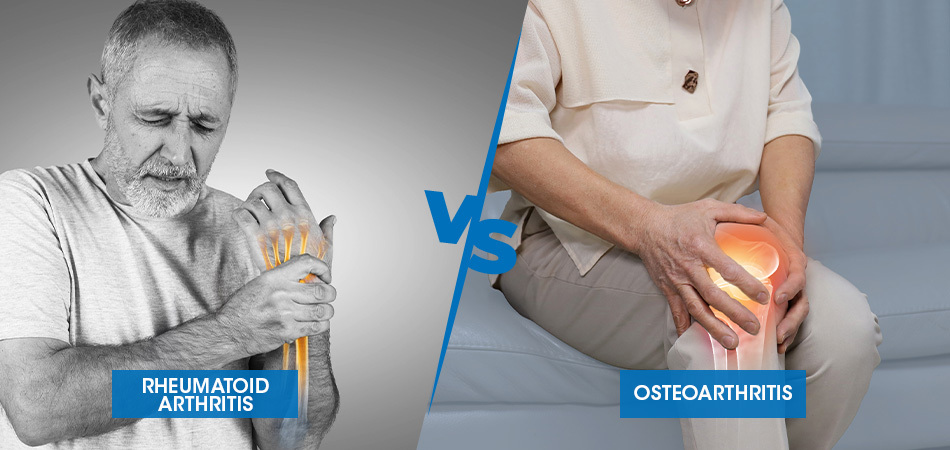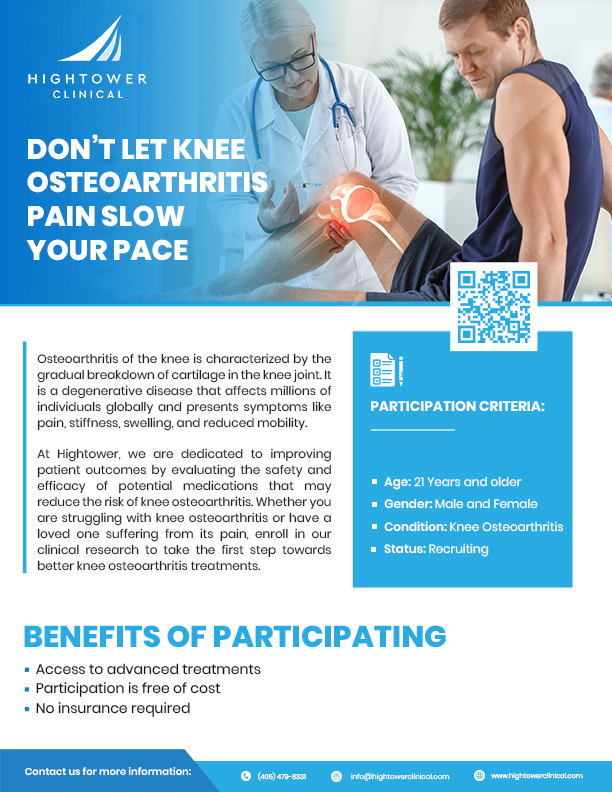Introduction
Do your joints feel stiff in the morning, making it hard to move? If so, you’re not alone. However, many people experience joint pain but don’t know whether it’s osteoarthritis or rheumatoid arthritis. Nonetheless, both conditions affect the joints, they have different causes, symptoms, and treatments.
Osteoarthritis happens when cartilage breaks down due to age, wear and tear, or past injuries. In contrast, rheumatoid arthritis is an autoimmune disease where the body attacks its own joints, leading to inflammation. Therefore, treatment depends on the correct diagnosis, knowing the difference is crucial.
This guide will explain what sets these conditions apart, how they progress, and what treatments are available. However, if you’re looking for expert advice on arthritis management, visit your nearest physician without a delay.
What Is Osteoarthritis?
Osteoarthritis is the most common type of arthritis. However, it happens when cartilage, the cushion between bones, gradually wears away. As a result, bones rub against each other, causing pain, stiffness, and swelling.
Causes of Osteoarthritis
- Aging: The risk increases as you get older.
- Joint Overuse: Repetitive movements put extra stress on joints.
- Injuries: Past injuries can speed up cartilage breakdown.
- Genetics: Some people inherit a higher risk of joint damage.
Symptoms of Osteoarthritis
- Joint pain that worsens with activity.
- Morning stiffness lasting less than 30 minutes.
- Swelling around affected joints.
- Reduced flexibility and difficulty moving.
Osteoarthritis commonly affects the knees, hips, spine, and hands. Therefore, as the condition worsens, daily activities like climbing stairs or gripping objects become harder. Moreover, studies show that nearly 32.5 million adults in the U.S. have osteoarthritis (CDC).
How Does Osteoarthritis Progress Over Time?
Osteoarthritis develops in stages:
- Early Stage: Firstly, cartilage starts breaking down, but symptoms are mild.
- Moderate Stage: Secondly, joint pain and stiffness become noticeable, especially after movement.
- Severe Stage: Lastly, cartilage is almost gone, causing chronic pain and restricted movement.
For those seeking new treatments for osteoarthritis and knee osteoarthritis can consider participating in clinical trials.
Osteoarthritis vs. Rheumatoid Arthritis: Key Differences and Diagnosis
What Is Osteoarthritis?
Osteoarthritis (OA) is a degenerative joint disease that develops over time. However, it occurs when the protective cartilage at the ends of bones wears down. As a result, bones rub against each other, causing pain, stiffness, and swelling.
Symptoms of Osteoarthritis
- Joint pain that worsens with movement.
- Morning stiffness lasting less than 30 minutes.
- Swelling and tenderness in affected joints.
- Reduced flexibility making daily tasks difficult.
What Increases the Risk of Osteoarthritis?
- Aging: The risk rises with age.
- Joint Overuse: Repetitive movements wear down cartilage faster.
- Obesity: Extra weight adds stress to joints, especially knees.
Treatment Options for Osteoarthritis
Doctors recommend exercise, weight management, and physical therapy. Therefore, for severe pain, treatments include joint injections or surgery.
What Is Rheumatoid Arthritis?
Rheumatoid arthritis (RA) is an autoimmune disease where the body’s immune system attacks the joints. Moreover, this leads to chronic inflammation, joint damage, and stiffness. However, unlike osteoarthritis, rheumatoid arthritis can also affect other organs.
Symptoms of Rheumatoid Arthritis
- Persistent joint pain and swelling.
- Morning stiffness lasting more than an hour.
- Fatigue, fever, and unexplained weight loss.
- Symmetrical joint pain, affecting both sides of the body.
Who Is at Risk for Rheumatoid Arthritis?
- Genetics: A family history increases the likelihood.
- Smoking: Tobacco use raises the risk of RA.
- Environmental Triggers: Exposure to certain infections may play a role.
How Does Rheumatoid Arthritis Progress?
RA starts in small joints like fingers and toes. Over time, it spreads to larger joints and can lead to joint deformities if untreated.
Osteoarthritis vs. Rheumatoid Arthritis: How Do They Differ?
Although both conditions cause joint pain and stiffness, they have key differences:
| Feature | Osteoarthritis | Rheumatoid Arthritis |
|---|---|---|
| Cause | Wear and tear | Autoimmune response |
| Onset | Gradual | Sudden or gradual |
| Morning Stiffness | Less than 30 minutes | Over an hour |
| Swelling | Mild | Significant, often with redness |
| Affected Joints | Knees, hips, hands, spine | Small joints first, then larger ones |
| Symmetry | Affects one side first | Affects both sides equally |
| Systemic Effects | No | Yes, may affect heart, lungs, and eyes |
Explore New Possibilities for Knee Osteoarthritis Treatment
Osteoarthritis (OA) and rheumatoid arthritis (RA) are both joint conditions, but they have distinct causes and effects. OA develops due to cartilage wear and tear, leading to joint stiffness and pain. In contrast, RA is an autoimmune disorder that causes inflammation and joint damage. Understanding these differences is crucial for proper diagnosis and treatment.
If you’re experiencing joint pain, stiffness, or swelling, consult a healthcare professional to explore the best treatment options.
Treatment Differences
- Osteoarthritis: Focuses on pain relief and joint function. Common treatments include physical therapy, pain relievers, and joint injections.
- Rheumatoid Arthritis: Requires immune-suppressing drugs, such as DMARDs (disease-modifying antirheumatic drugs), to slow disease progression.
How Do I Know If I Have Osteoarthritis or Rheumatoid Arthritis?
Getting the right diagnosis is crucial. Here’s how doctors differentiate the two:
Key Diagnostic Factors
- Osteoarthritis: X-rays reveal cartilage loss and bone spurs.
- Rheumatoid Arthritis: Blood tests show high inflammation markers like Rheumatoid Factor (RF) and Anti-CCP antibodies.
When to Visit a Doctor?
- If you have persistent joint pain that worsens over time.
- If your joints swell and feel warm to the touch.
- If stiffness lasts more than an hour, especially in the morning.
Imaging tests like MRIs and X-rays help confirm the diagnosis. Nevertheless, doctors perform joint fluid analysis to rule out other conditions.
Commonly Mistaken Conditions
- Gout: Causes sudden joint pain due to uric acid buildup.
- Psoriatic Arthritis: Often occurs with psoriasis, leading to joint inflammation.
- Lupus: Can cause joint pain but also affects other organs.
Can Osteoarthritis Turn into Rheumatoid Arthritis?
Many people wonder if osteoarthritis can develop into rheumatoid arthritis. However, these are two separate conditions with different causes.
Why Osteoarthritis Cannot Turn into Rheumatoid Arthritis
- Firstly, osteoarthritis is caused by joint wear and tear, while RA is an autoimmune disorder.
- Secondly, OA affects specific joints, whereas RA affects the whole body.
- Lastly, RA involves immune system dysfunction, while OA is purely mechanical damage.
Can You Have Both Conditions?
Yes, some people develop both osteoarthritis and rheumatoid arthritis. However, this is more common in older adults who already have joint damage and later develop autoimmune inflammation.
According to a 2023 study published in Arthritis & Rheumatology, 15% of people with RA also develop osteoarthritis in the same joints.
Final Thoughts
Osteoarthritis and rheumatoid arthritis share similar symptoms, but their causes and treatments are different. However, understanding these differences helps in getting the right diagnosis and treatment. Moreover, early diagnosis and tailored treatment plans can significantly improve quality of life. Nonetheless, if you’re experiencing joint-related symptoms, consult a healthcare professional to determine the best course of action.





